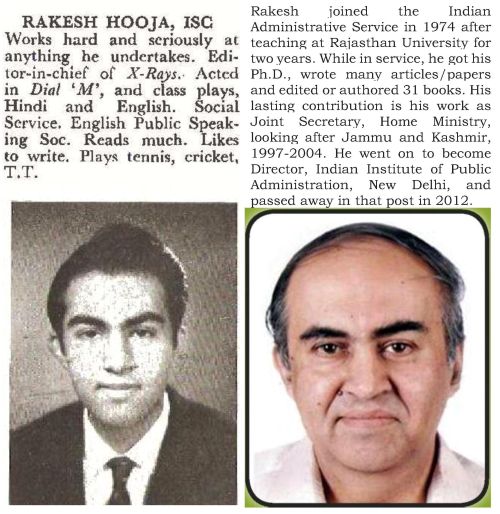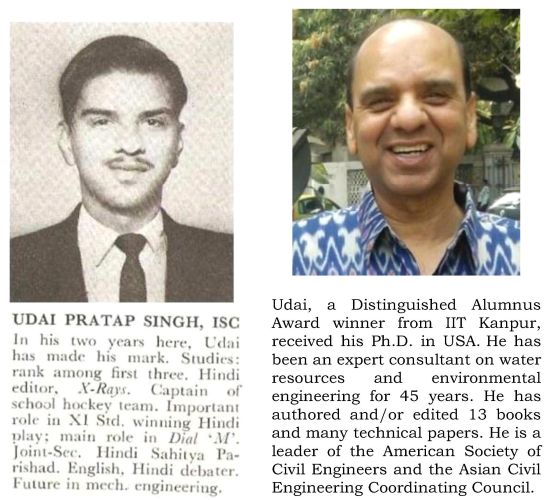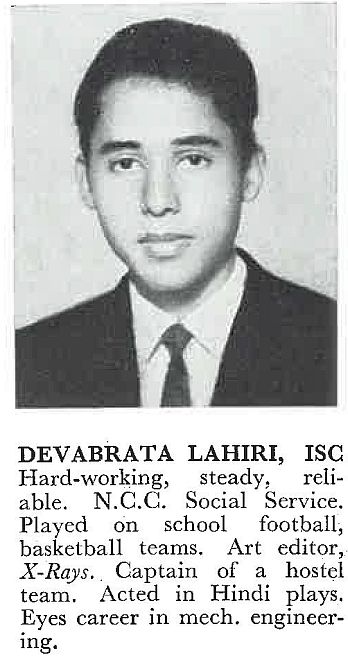Our school newsmagazine 1966
Category:
Editor's note: This article has been written by several people who were involved with the production of X-Rays, the newsmagazine of St. Xavier's School, Jaipur in 1965-66.







Subodh Mathur
Our class completed high school from St. Xavier's School, Jaipur in December 1966. In 1965, the school chose some of us to run the school's news-magazine X-Rays for that year. Our Chief Editor, Rakesh Hooja, passed away a few years ago. (He married my younger sister Meenakshi in 1976.) I think he was chosen because he was clearly the best writer in our class, and possibly in the school for a number of years. But, I think the school authorities did not know that he had strong opinions - unusual in our school at that time - about what he wanted to do as Chief Editor. When he found out that the school wanted continuity, not major change, he lost interest in being the Chief Editor, though he did not formally give up this title.
Like Rakesh, I also lost interest in being an X-Rays Editor. I don't remember the exact circumstances. My vague memory is that the teacher supervising us dropped an article I had written. The reason was that it did not fit the traditional mould. Still, I did not quit formally. It was unthinkable those days for students in our school to openly defy the authorities. So, my name stayed, but I don't remember writing anything.
Udai Pratap Singh
Initially, I was appointed as the Hindi Editor of X-Rays. I did this for the first few issues, writing at least one Hindi article and soliciting and editing Hindi articles from others for each issue. Later, the school authorities asked me to take over the Chief Editor's job for the rest of the year as Rakesh Hooja had lost interest in it and the issues of X-Rays had become very infrequent. Rakesh had become a good friend after we worked as actors in the school play Dial M for Murder. So I became the actual Chief Editor, and kept the Hindi editor job. Rakesh's name appeared as Chief Editor on each issue.
I found the new position more challenging than I had imagined. To get the X-Rays out twice a month, I had to co-ordinate with Associate Editors, correspondents, and many other students, while keeping in touch with the school authorities. In addition, I needed to visit the printers in town to coordinate closely with them during the publication process. I solicited most of the articles, though I would occasionally receive unsolicited articles. Much arm twisting, using friendly relations, and an occasional "bribe" of Gold Spot (a soft drink) or chocolate from the canteen took place to get articles from them in a timely manner. However, many writers only needed reminders, and came through with their stories in time.
The challenge for each issue was to come up with one or two main stories, and find writers for them. Usually, it was easy to find the lead story as there was always something eventful going on at the school. Once in a while, I had to write one of the lead stories myself. The remaining articles filled up the other pages, and we had to scramble to get the right number and length of articles to completely fill each issue. Most issues had six pages. When we did not have enough material, I would create a 4-page issue to keep the publication fortnightly.
There was a technical reason why I could not delegate much of the editing to the Associate Editors. I lived in the school hostel, while most of the editors lived in the city at home. They were not easily available outside school hours, when most of the editing work had to be done. In addition, I did not know how to type, an essential part of the editing and publication process.
I was fortunate to have Vijay Bagaria, one of the correspondents, as a close friend who knew how to type. Plus, like me, he lived in the hostel. So, I offered him the "co-editor" job, which was not an official position. Still, he accepted, as it looked like a lot of fun!
The school provided us a small room in our hostel building for the X-Rays editing office soon after I took over. It had a desk, a couple of chairs, and a typewriter, and offered a refuge for getting away from the shared facilities and rooms of the hostel. I used it for my own private study room in addition to doing X-Rays work, as only I had the keys to this room, and gave them to Vijay whenever he wanted them. (See Vijay's piece below for how we did the editing, including the typing and printing coordination.)
One aspect of the job was to go to the printer in town with the proof or "dummy" of the upcoming issue and coordinate it through its publication. This turned out to be great fun.
Vijay and I lived in the hostel. The rules were strict. No hostel student could leave the school campus without explicit permission from the Hostel Superintendent. And, he rarely gave this permission to anyone. However, Vijay and I got a free pass to rush to the printer as needed - without permission! Time was of the essence in getting the issues out, and the Superintendent didn't want to delay the publication.
Initially, we just went to the printer and came back dutifully. Nothing else. Soon, we started getting ideas about what else we could do as we went more and more into town. Soon we started combining the visit to the printers with going to Kwality ice cream shop, having snacks at the park thelas, or even at Niro's or LMB (famous local restaurants).
Later, we started going out into town almost every weekend, printers or not, to have our own outings away from the confines of the hostel. We just made sure that we would have a copy of the latest proof or "dummy" of X-Rays on us if a school authority saw us leaving or re-entering the campus. We would wave the proof at them, and say "To the printers" or "From the printers." Nobody asked us any questions.
Vijay and I saw our share of new movies in town during weekend afternoons. I remember seeing Gumnam with him on one of these escapades, and the person sitting behind me identifying loudly the killer about one-third into the movie. I was mad at him initially for divulging the killer in the whodunnit, but was not so angry after seeing that "killer" dead a few minutes later, only to realize at the end of the movie that it indeed was the killer, as he had faked his own killing earlier in the movie.
Vijay's family had a house, Bagaria Bhawan, in town. His family was living in Assam, but the house was furnished and had an Ambassador car in the garage for their use during visits. It was a locally prominent house - even today the area in which it is located is called Bagaria Bhawan, though the Bagaria family does not own it now.
Vijay and I would occasionally go to the house, pick up the car, and drive it into town and beyond. I knew some driving by that time, and honed my driving skills during the escapades, as Vijay let me drive much of the time. We even tried our racing skills (see how fast the Ambassador can go) on the open Jaipur-Alwar Road for quite a distance. Luckily no accidents or damage to the car! Vijay and I recalled those fun escapades when we met in 2016 at our Class Golden Jubilee Reunion. And no one else knew that we did more than visiting the printers. I had not realized all the benefits of the acting Chief Editor position when I took it!
I have chosen to show the issue of X-Rays that was published in January 1966. It shows one of our class and school accomplishments (visit to the PM to donate the proceeds from our school play into the NDF) and several other activities underway during the beginning of the school year after a few weeks off. It was likely my second or third issue in the lead role, and even today I am very proud of the outcome.
Vijay Bagaria

What went into the publishing of the school journal, appropriately titled the "X-Rays"? It was journalism at its best - inviting articles on various subjects from students and compiling all the material, removing the unwanted, clipping here and there, typing, printing and eventually coming out with the best possible version. My friend Udai was on the editorial board as Hindi editor whereas I was only a Scouts Correspondent, as I was a Senior Scout Troop Leader. However, as Udai has written, circumstances forced the two of us into playing the key roles as the de-facto editorial team.
Let me tell you about my major contributions - typing and getting the printing done.
Those were primitive days, compared to today. All we got was a small, portable, noisy, manual typewriter. It looked like this.

Type of typewriter I used in 1965-66 to type articles for X-Rays.
It was probably a vintage Hermes - or was it a Remington? We used this as efficiently as possible to produce the first texts. Generally, we received hand-written articles but it was necessary to type them out neatly to avoid printing errors and minimize proof-reading in later stages.
Once the typing was done, we produced a ‘dummy version' by placing each article in its suitable position. We then visited the printing press, which was Jaipur Printers, located on M I Road, quite near our school.
While compiling this piece I was anxious to find out if Jaipur Printers still exists. Google maps enabled me to locate Jaipur Printers at the same location on M I Road. Then, using Linked-in I was fortunate to establish contact with Anurag Jain, one of the young owners of Jaipur Printers. From Anurag I was able to obtain this picture of the press that was used then.

Printing press, Jaipur Printers. Mid-1960s.
His grandfather Shri Sohanlal Jain used to run the press during our days of the X-Rays.

Sohanlal Jain. Owner, Jaipur Printers, Jaipur.
Just like our typewriter, the printing press in those days was mainly manual. The typesetting process consisted of picking out every letter one-by-one and placing it into a tray that would eventually go into printing a single page of the X-Rays. The type-setters worked mechanically with deft fingers to place the letters in their correct position. The tray would then be placed into the machine where the first prints would be produced.
Udai and I carried the printed pages back to the school for proof-reading. This involved eliminating the proverbial printer's devil and making small improvements here and there. Each such correction had to be indicated separately for the printers to understand in their own language. Then, we had to cut out the printed sheets into smaller pieces and paste them on to blank sheets of paper in a logical sequence, much like a jig-saw puzzle, to produce a final ‘dummy version'. Finally, the printer would make the corrections, show us another proof on the spot, and proceed with the final printing of the required quantity - possibly about 1500 copies.
It was our job to ensure flawless copies of the X-Rays issue after issue almost every fortnight. The end result of our efforts gave us immense satisfaction and a sense of achievement.
A sample issue

Page 1 of X-Rays, Newsmagazine of St. Xavier's, Jaipur, 1966.
A story about the play that took us to the Prime Minister is here.
Udai Pratap Singh
The lead story of this issue was a "no brainer". I had a lead role in the play but could not go with the class and school authorities to see the PM due to a family schedule conflict. It was another "no brainer" that Surajit Sanyal, an Associate Editor as well as an actor in the play, would write it. He had taken the trip, was very happy to accept the writing opportunity, and did a great job. Vijay and I did minimal editing to fit the photo and article all on one page.

Page 2 of X-Rays, Newsmagazine of St. Xavier's, Jaipur, 1966.
Udai Pratap Singh
We usually positioned the Editorial on page 2. We asked anyone to take turns in writing the Editorial on anything on his mind. R. S. Rao, one of our classmates, was not a very active participant in most school activities, and was quiet most of the time. I knew that he was a Chhupa Rustam (secret warrior) and requested him to write this issue's Editorial. He was happy to do so (no bribes needed!), and did a good job, and in time.
Devpriya Lahiri was a year junior to us and an active participant in X-Rays. He produced this article without any solicitation.
Rakesh had lost interest in X-Rays by this time, but I was determined to get an article out of him. This one took a little effort and a little "guilt trip" on Rakesh's part, as he was still listed as Chief Editor. Finally, he agreed to write one on any topic he chose. He selected how a student spent the few weeks of winter holidays (December/January). Interesting piece! I did no editing and put it in just as submitted even though it ran into the next page.

Page 3 of X-Rays, Newsmagazine of St. Xavier's, Jaipur, 1966.
Udai Pratap Singh
As Hindi Editor, I almost surely had to write an article in this issue. I selected to do a short one on our condolence meeting for Indian Prime Minister Shastriji. Kamal Shivpuri and Mohan Lal Tank co-wrote the article on NCC Camp during the holidays without any reminder from me. Vijay and I did minimal editing to fit it into the page.

Page 4 of X-Rays, Newsmagazine of St. Xavier's, Jaipur, 1966.
Udai Pratap Singh
Fr. Grace, our supervisor, suggested that I write the Teacherwise article. I didn't know the history of Xavier's Jaipur, as I transferred from St. Xavier's Patna to Jaipur only in January 1965. But I did some research, got their photos, and came up with the article. Vijay did his piece as he was the Scouts correspondent. But I do not remember how the article on "Old Boys" came about.
Vijay Bagaria
As the Senior Scouts Troop Leader I had the opportunity to get training under different "Scout Masters". Mr A A Sayed was a veteran of many years (besides an outstanding English teacher). We also had Mr R L Sharma for a few years. Mr Isaac Barno was a young and energetic scout master with whom we soon struck the right wave-length.

Page 5 of X-Rays, Newsmagazine of St. Xavier's, Jaipur, 1966.
Udai Pratap Singh
Shantanu Consul was a good writer. I think he came up with both articles on Page 5 by himself, though he usually needed a little reminder and an occasional "pleading" to get it done in time. Only minimal editing to fit the space. Om Prakash Sharma, a year junior to us, came to me unsolicited and gave me this brilliant humorous Hindi poem. I published it without any change. Devabrata Lahiri was our Art Editor. He almost always came up with a creative funny strip in each issue.

Page 6 of X-Rays, Newsmagazine of St. Xavier's, Jaipur, 1966.
Udai Pratap Singh
The last page of the issue was always a challenge. I had enough material for five pages for this issue, but it had to come out in four or six pages to avoid a blank page. Luckily, Rajendra Kumar, a year junior to us, asked if he could submit an article. I said, "Yes, as long as you submit it to me by tomorrow". And he did. With minimal editing, it filled up two columns. So I had the challenge of finding something for the last column on the page.
With time running out, I decided to write a potpourri article on any recent news not covered in the issue. I could think of something on the Senior Lounge and the room that was given to X-Rays staff (see earlier mention of it at the beginning of this story). I titled it "Finally...!" so appropriately.
But, when Vijay typed and pasted it on the page, it still left some unfilled space at the bottom of the column. So at the last minute before taking it to the printers, I wrote the paragraph on "Cinema Review" and that did the trick. Just perfect 6 pages!
_______________________________________
© Individual authors Published June 2019
Comments
Add new comment